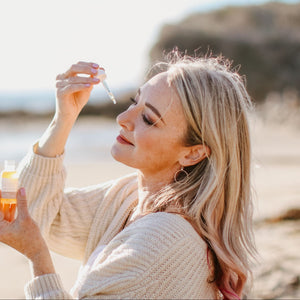You’ve no doubt heard it all. Life hackers and self-proclaimed skincare experts talking about the ‘best’ DIY Skincare Hacks. It’s easy to get sucked into the popularity. But, is DIY Skincare as good as it’s bragged about? I debunked 5 common mistakes that people make and why they don’t work.
I know, I know. Mixing up a few ingredients and formulating your own mask is enjoyable. But, there are key reasons why skincare brands (like this one) create their products in the way they do. Following all sorts of guidelines, regulations and thinking about you all the way.

Anyway, here are the mistakes you could be doing:
1. Applying Fresh Lemon on Your Face
There are theories that applying fresh lemon (yes, the ones in your fridge) can get rid of dead skin cells. Also helping with exfoliation. Lemons are rich in vitamin C, helping with hyperpigmentation, but it’s got downsides.
Lemons are extremely acidic (at 2 pH) and can aggravate your skin problems. When you’re making your masks, this substance can result in redness and dryness. Effects can be worse if you have sensitive skin.
A 2019 study mentioned that using lemon on your face can cause skin irritation, sunburn and leukoderma.
2. Using Toothpaste as an Acne Treatment
You’ve all heard this one. Applying toothpaste to your pimples can cause them to dry out. Use a cotton swab and wake up to clear skin in the morning.
Toothpaste does contain baking soda, essential oils and hydrogen peroxide which can help. But, you can be causing more harm than good. Most toothpaste use sodium lauryl sulfate, which is too harsh on blemishes.
If you’ve got sensitive skin, toothpaste can result in redness and can make breakouts more frequent as
3. Using Poorly-Preserved Ingredients
Egg whites, citrus fruits, cinnamon, ripe avocado. You’ve heard it all. Some of these ingredients may have their benefits. But the risks of using them are not worth the small beauty benefit.
For instance, people tend to add egg whites into their DIY skincare but fail to take precautions. Failing to preserve the ingredient and ensure it’s safe to use. Without effective precautions, these ingredients tend to sit on top of your skin.
Without effective catalysts, these ingredients can worsen your skin problems. There’s no effective system of keeping the ingredients safe, so bacteria can spread. You all know the dangers of bacteria on the skin. They make acne breakouts more likely.
4. Baking Soda as an Exfoliator?
Yes, that’s right. I’ve seen a few self-appointed beauty gurus talk about the benefits of baking soda. Mentioning that the extract can help with acne, eczema and even chickenpox.
Cynthia Cobb (a famous nurse practitioner in skincare) said that baking soda can lead to dryness, irritation and other side effects.
This is because baking soda is an alkaline, altering the natural pH of your skin. It also makes the solution too basic to use as a face wash. Stripping the skin of necessary oils and making breakouts more likely.
Before exfoliating your skin with baking soda, do your due diligence with research. You could be aggravating your problems.
5. Bathroom Surgery
I like to call this mistake ‘bathroom surgery’. When a person notices a breakout, their mind
is drawn
to one thing. Using their expertise and trying to get rid of pimples, acne and blackheads the unsafe way.
This ties into everything. Using nail clippers (yes, people do use them), unsanitized hands and more. When you use unsanitary devices, you’re spreading bacteria quicker than you even know. Resulting in pain and aggravating your skin problems.
Instead of becoming the ‘bathroom surgeon’, I recommend looking for spot treatments. Ingredients such as chamomile, tea tree and peppermint oils are key ones. Following a tailored skincare routine is vital as well.
6. Scrubbing Your Face with Cinnamon
This challenge caught my eye. Beauty blogs creating DIY face masks and sprinkling sweet cinnamon on top. The extract does have health benefits, but it’s the contrary for your skin.
The red spice and your skin aren’t best friends. When applied to your skin (even the smallest amount) you could feel a burning feeling. With sensitive skin, it can cause redness, irritation and more.
According to experts, you may still be hypersensitive to the spice, even if you don’t have an allergy.
7. Using Fruit Powders for Lip Balms?
Let’s top of all the above mistakes with this one. I recently read a blog post. The writer was talking about the ‘best DIY lip balms’ and used fruit powders to create a tinted balm. Beetroot powder to be specific.
The problem with fruit powders is that they’re not oil soluble. Most of these powders disperse in oils and
eventually
sink to the bottom. When this happens, there’s no color effect on your skin. In other words, your lips moisture levels will be the same before and after application without the promised tint.
Before you create your lip balms, do your research with ingredients. Lip Balms that contain vitamins and some types of essential oils are your best-friend. You’ll feel the moisture almost immediately. Plus, they are effective against chapness.
The Bottom Line
As tempted you may be to try DIY Skincare. You’ve got to be diligent. Be careful with self-proclaimed beauty gurus, asking you to mix ingredients. Even if the ingredients seem harmless, you could be doing more damage than beauty.
If you decide to be creative and test, be careful with who you listen to. With sensitive skin, mixing the wrong ingredients could worsen your skin problems. It’s fine to test but listen to those credible –
preferably
a dermatologist.



 https://heathergraceskincare.com
https://heathergraceskincare.com